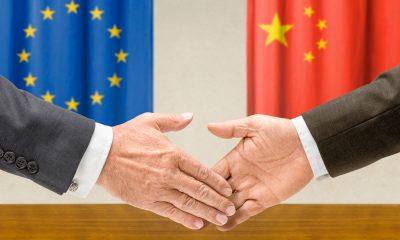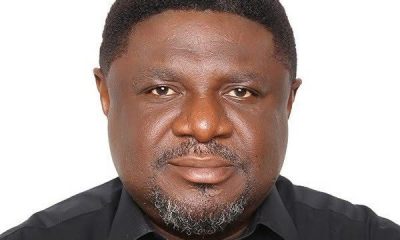Foreign
At Moscow Zoo, a panda family charms crowds and symbolizes China-Russia friendship

By Xiao Xinxin, People’s Daily
“She’s as beautiful as her name — just like the song!” exclaimed eight-year-old Darya from Moscow, beaming as she watched giant panda Katyusha gnawing contentedly on bamboo shoot while lounging on a climbing frame. “My friends and I love her. We often come here to take cute photos.”
The panda house of the over-150-year-old Moscow Zoo is infused with Chinese aesthetics — red gateways, lush bamboo groves, and traditional Chinese landscape paintings. It has become a popular destination for visitors and selfie-takers alike. Inside, Katyusha and her parents, Ruyi and Dingding, have won over a loyal following in Russia.
On June 5, 2019, Chinese President Xi Jinping and Russian President Vladimir Putin attended the inauguration ceremony of the panda house in Moscow Zoo. That day marked the debut of Ruyi and Dingding in front of an enthusiastic public.
Four years later, on August 24, 2023, Dingding gave birth to her first cub — a female — bringing joy and excitement to the Russian public. Over 380,000 people participated in an online poll to choose a name for the cub. The result, announced in January 2024, was “Katyusha,”named after the beloved classic song widely cherished in both China and Russia.
“Though she’s not yet two years old, Katyusha has already become an internet sensation, just like her parents,” said Svetlana Akulova, head of the zoo. Thanks to attentive care from all sides, the panda family is thriving. Ruyi is energetic and often interacts with visitors through the glass. Dingding, more reserved, has impressed caretakers with her intelligence. Katyusha, now weighing about 65 kilograms, began living independently at the end of April this year and is still adjusting to her new routine.
To help the panda family adapt well to their new environment, the panda house was upgraded based on the guidance and technical standards provided by Chinese experts. Every aspect — from their diet to housing — is overseen with precision. In response to the high public interest, the zoo has installed eight livestream cameras, offering daily broadcastsof the giant pandas’ routines from 9 a.m. to 9 p.m.
Akulova regularly shares updates via social media, chronicling Katyusha’s journey from the moment she first opened her eyes and lifted her head, crawling, standing, and now venturing into independent life. Each milestone, she says, brings a deep sense of pride.
“The giant pandas are shared treasure of our two peoples and a symbol of China-Russia friendship,” she said. “We will continue to care for them with love and dedication, preserving this living bond and bringing our peoples ever closer together,” she said.
Foreign
In China’s lighter capital, a glow of resilience amid global uncertainty

By Wang Ke, Yan Ke, People’s Daily
In central China’s Hunan province, the city of Shaodong, known as China’s “lighter capital,” hums with precision and automation. Here, more than 15 billion lighters roll off the production lines each year — roughly 70 percent of the global supply.
As the international landscape grows increasingly unpredictable, this manufacturing hub is adapting with a mix of agility, innovation, and diversification.
Inside the production workshop of Hunan Dongyi Electric Co., Ltd., robotic arms move in synchronized motion acrosssix automated lines, assembling lighter components at remarkable speed. The company ships more than a million lighters each day to buyers around the world.
“Our orderbooks are full through October,” said Bai Jiabao, deputy general manager of Dongyi Electric. The company exports more than 99 percent of its products, andin 2023, it recorded nearly $300 million in overseas sales — a 5 percent year-on-year increase. That momentum has continued into the first quarter of this year.
Facing mounting global uncertainty, Shaodong’s lighter manufacturers are hedging risk by expanding into new markets.
“Our clients are from more than 100 countries and regions,” Bai said. “That diversity gives us a buffer and strong resilience.” He noted that emerging markets such as the Middle East and Southeast Asia have seen increasing demand in recent years.
“No country can stop the momentum of globalization,” said Lyu Shenghua, chairman of Huanxing Lighter Manufacturing Co., Ltd., another company based in Shaodong, which exports to over 80 countries and regions and maintains a network of hundreds of stable buyers. According to Lyu, Shaodong’s lighter companies have actively pursued new markets, achieving remarkable results and maintaining robust growth.
Bairecently returned from the 137th China Import and Export Fair, also known as the Canton Fair. “Buyer turnout exceeded previous sessions,” he said.”We’re very optimistic.”
According to statistics, in the first quarter of this year, Shaoyang exported 480 million yuan ($66.32 million) worth of lighters and related parts to Belt and Road partner countries, up 48.5 percent year on year. Exports to the least developed countries also climbed by 13.3 percent, reaching 60 million yuan.
Inside Huanxing’s product showroom, eight major series and more than 200 types of lighters line the shelves.Among them, a new model of torch lighter has emerged as a breakout success.
“This torch lighter has become one of our fastest-growing products,” Lyu explained. In 2023, after conducting extensive market research in its key export destinations, the company identified a surge in demand for outdoor torch lighters, driven by the global boom in camping and recreational activities. Huanxing swiftly ramped up R&D investment and increased manpower towardthe design of a lighter tailored for these trends.
“We offered a few samples to a select group of long-term clients for testing. The feedback was overwhelmingly positive, and orders quickly followed,” said Lyu. The product soon gained traction at major international trade fairs, becoming one of the company’s standout products. Last year, this single innovation delivered double-digit growth in the company’s total sales.
“Innovation is our driving force. If a product is good enough, it will find its market,” Lyu said. Mid- to high-end models, he noted, now make up a growing share of the company’s exports.
Dongyi Electric has taken a similar approach. Since 2016, the company has allocated 20 million yuan annually to R&D. After four years, it achieved full automation across every stage of production — significantly cutting costs and improving product quality.
“A workshop that once needed 200 workers now requires only 40,”Bai said.”And production capacity has increased ninefold.”
Shaodong’s success in scaling up innovation owes much to its robust and highly localized supply chain. The city is home to 114 lighter-related manufacturers, including over 80 suppliers. This creates a tightly-knit industrial cluster. More than 200 types of lighter components can be sourced locally — all within a 20-kilometer radius.
As the global trade environment grows more complex, Shaodong companies are also looking inward. Many are developing integrated sales strategies to tap into China’svast domestic market.
“Our domestic business now accounts for about 70 percent of total sales,” said Liu Hanjiang, general manager of Hunan Haopai Electric Co., Ltd., which specializes in mid-end lighters priced between two and five yuan. The company releases four to five new models each year and produced over 100 million lighters last year.
With a blend of innovation, market diversification, and domestic market expansion, Shaodong’s lighter industry is establishing new strategic positions within global supply chains. This transformation is driving the sector toward higher-quality development and laying the groundwork for a more resilient future.
Foreign
Auto Shanghai showcases China’s fast-track transformation in auto industry

By Wang Zheng, People’s Daily
From April 23 to May 2, the 21st Shanghai International Automobile Industry Exhibition (Auto Shanghai 2025) was held at the National Exhibition and Convention Center (Shanghai). Featuring nearly 1,000 exhibitors from 26 countries and regions, the event showcased over 100 new vehicle models and cutting-edge technologies.
At the exhibition, a new energy SUV capable of crab-walking, tank turns, and running on flat tires was displayed. This model is able to “sail” through water up to 80 centimeters deep for two hours.
There was an advanced assisted driving system that can autonomously navigate multi-floor underground parking garages and charge itself. A power battery with a volumetric energy density exceeding 1,000 Wh/L also caught great attention.
These are just a few of the highlights from the Auto Shanghai 2025, where Chinese electric vehicle makers and suppliers astonished visitors with their latest innovations in electrification and intelligence technologies.
“China’s leadership in electrification and intelligent technologies is leading the global auto industry transformation,” said Stephen Ma, chairman of Nissan China Management Committee and president of Chinese carmaker Dongfeng Motor.
“Nissan is leveraging China’s advantages in technology and resources to collaborativelydevelop innovative and competitive products,” he added.
A range of forward-looking driver-assist technologies were unveiled by mainstream automakers at the exhibition.
Chinese new energy vehicle manufacturer GAC Aion partnered with ride-hailing platform DiDi to debut Robotaxi, a Level-4 autonomous model, which is scheduled for rollout by the end of this year and pilot operation in 2026.
Meanwhile, Chinese tech giant Huawei launched its Qiankun ADS 4 system, which reduces end-to-end latency by 50%, improves traffic efficiency by 20%, and cuts hard braking incidents by 30%.
“Huawei has already completed 600 million kilometers of Level-3 expressway self-driving simulations and validations via our cloud-based World Engine. We’re now ready for commercial mass production of Level-3 autonomous driving,” said Jin Yuzhi, CEO of Huawei’s Intelligent Automotive Solution.
The “China speed” of innovation is also evident in the chip sector.
Chinese technology company Horizon Robotics unveiled its Journey 6P chip – currently the most powerful domestically produced intelligent driving chip with 560 TOPS of computing power – and launched China’s first full-stack Level-2 urban driver-assist system integrating both software and hardware. The system will debut in mass production on EXEED brand of Chinese carmaker Chery this September.
Auto Shanghai 2025 also marked a new chapter in joint ventures, as multinational automakers unveiled collaborative projects developed primarily in China. SAIC Volkswagen took the lead in developing Volkswagen’s first full-size extended-range electric vehicle SUV concept. Dongfeng Nissan spearheaded the creation of the pure-electric N7 sedan. Chinese automobile manufacturer Changan Automobile and Mazda co-developed the EZ-60, a new energy model under the Changan Mazda brand.
From “made in China for China” to “made in China for the world,” multinational carmakers are shifting their role in China from a manufacturing hub to global contributors of technological innovation.
Two years ago, Ola Kaellenius, chairman of the board of management of Mercedes-Benz, said that China’s pace of innovation is astonishing, particularly in electrification and digitalization, which is far ahead of the rest of the world. This remark has now been fully validated by the company’s latest progress in China.
At the Auto Shanghai 2025, Mercedes-Benz debuted its long-wheelbase, all-electric model CLA globally. The development of this model’s all-scenario driver-assist system was led by the carmaker’s Chinese R&D team, which took just 18 months. That speed would not have been possible without the support of the company’s two major R&D centers in Beijing and Shanghai and a local team of over 2,000 engineers.
Artificial intelligence (AI) was ubiquitous at the Auto Shanghai 2025. From smart cabins redefining human-vehicle interaction, to integrated driver-assist systems breaking through application boundaries, and to large models powering end-to-end business innovation, a new vision with AI-driven intelligent vehicles serving as the neural hub is becoming clear in the wave of auto industry’s transformation.
BMW, following a strategic partnership with Alibaba on large language models and the launch of an AI agent developed by its China-based R&D team, announced further integration with DeepSeek to strengthen its AI ecosystem in China.
Dongfeng Motor exhibited an enterprise-grade large model. With AI-powered design assistants, coding copilots, and simulation tools, the model cuts new vehicle development cycles by over 35% and reduces collaboration costs by 30%.
Gan Jiayue, CEO of Chinese automobile giant Geely Auto Group, said that the company has integrated AI across its entire smart vehicle ecosystem, from architecture and powertrain to chassis, cabin, and driver assistance.
It has also deeply embedded AI into the entire value chain from product development and manufacturing to after-sales service, to deliver a truly intelligent, all-scenario user experience, he added.
Li Xianjun, director of the automotive development research center at Tsinghua University’s School of Vehicle and Mobility, noted that AI-powered electrification and intelligent technologies are accelerating disruptive innovation in the auto sector.
He urged automakers to rapidly formulate AI-driven strategies and build new organizational systems with innovative mechanisms, processes, talent, and culture to speed up their transformation.
Foreign
China-EU economic, trade cooperation brings greater stability to global economy

By Guo Ziyun, Yu Limin, Niu Ruifei, People’s Daily
This year 2025 marks the 50th anniversary of the establishment of diplomatic relations between China and the European Union (EU). As the world’s second and third largest economies, China and the EU collectively account for over one third of the global economy and more than a quarter of global trade. Both sides are advocates of economic globalization and trade liberalization, and firm defenders and supporters of the World Trade Organization.
Over the past five decades, the two sides have continued to deepen their economic and trade cooperation, benefiting the two peoples and the world at large. As the global economy faces mounting instability and uncertainty, closer communication and cooperation between China and the EU can contribute to open and free trade and investment, ensure stable and unimpededglobal industrial and supply chains, and inject greater stability and certainty into the world economy.
In the western Polish city of Slubice, the rhythmic hum of conveyor belts fills a warehouse run by MBB Logistics, where workersmethodically sort and dispatch packages destined for consumers across Poland and Germany — usually within 24 hours.
This warehouse is part of a growing logistics footprint made possible by the China-Europe freight service. Over the past several years, MBB Logistics has expanded into eight warehouses in the region, covering 160,000 square meters and handling a wide range of goods including electronics, mechanical parts, household supplies, and hardware. Sourced from nearly 300 Chinese e-commerce partners, these goods form a bridge between thousands of Chinese manufacturers and the vast European market.
Julio Rios, a Spanish expert on China, observed that the China-Europe freight service addresses the needs of both China and Europe in a complementary and innovative way. He views the freight service as a catalyst for unleashing the economic and trade cooperation potential of countries along the route.
As morning light pierced the mist and spread across the vast Hungarian plains, rows of sand martin nests dotted the rocky embankment near the tracks of the Budapest-Belgrade railway– home to hundreds of the birds.During the railway’s construction, Chinese builders went to great lengths to protect the birds’ habitat, which has since become a cherished story in the local community.
The Hungary-Serbia railway is a vivid example of China and the EU jointly building green Belt and Road.
In Greece, Chinese enterprises are actively promoting green and digital transformation at the Piraeus port, striving to transform it into a sustainable, efficient, and intelligent port.
In Malta, the Delimara 3 power station, upgraded by a Chinese company, now emits significantly less pollution and carbon than EU environmental standards require, shifting from a heavy polluter to a model of green innovation.
In Serbia, the Chinese-built Kostolac Power Plant is converting ash and slag into exportable concrete materials, reducing dust emissions while generating revenue.
These green projects and technologies are propelling Europe’s green transition and injecting new momentum into regional economic development.
Fabian Zuleeg, chief economist at the European Policy Center, sees vast potential in China-EU trade and investment cooperation, especially in tackling climate change. With shared goals and a growing alignment on green priorities, he noted, both sides recognize the scale of business opportunities ahead.
European companies express growing confidence in the Chinese market through tangible investments. France-based cosmetic giantL’Oreal has launched two new investment funds in China. German industrial giant Siemens opened its first industrial ecosystem hub in western China in Chengdu, Sichuan province. Danfoss, a global refrigeration industry giant headquartered in Danmark, inaugurated its first carbon-neutral factory in China, located in Nanjing, Jiangsu province. According to China’s Ministry of Commerce, actual investment from the EU to China rose by 11.7 percent in the first quarter of this year.
China-EU investment cooperation continues to expand, particularly in areas such as new energy, green technology, and smart manufacturing.
Greece’sPiraeus Port Authority S.A., operated by a Chinese company, posted record-high revenues and profits in 2024. In the first quarter, Chinese electric vehicle battery giant CATL saw strong year-on-year growth in power battery sales in the European market, with its factory in Thuringia, Germany achieving profitability. Meanwhile, Chinese automaker Chery Automobileand Spain’s Ebro-EV Motors signed a pact to develop new electric vehicles through a joint venture, breathing new life into a cherished local brand.
Bernard Dewit, chairman of the Belgian-Chinese Chamber of Commerce, noted that Chinese and European companies continue to demonstrate innovation and resilience. In anincreasingly complex international environment, he said, they are forging win-win partnerships and opening up broad development prospects.
-

 News9 hours ago
News9 hours agoCBIAMEC Congratulates NCDC Board Member, Solomon Adodo
-
News8 hours ago
Saraki committee: PDP on the path to resurgence- Utaan
-

 Entertainment9 hours ago
Entertainment9 hours agoBarry Showkey Set to Drop New Single “ROBOROBO” on May 15
-

 News2 hours ago
News2 hours agoACN Condemns Oil Merchants for Orchestrated Protests Against Mele Kyari
-

 Foreign5 hours ago
Foreign5 hours agoTo work toward even brighter future for China-EU relations
-

 Foreign5 hours ago
Foreign5 hours agoTraditional Chinese medicine bridges hearts between China, Russia
-

 News11 hours ago
News11 hours agoSaraki committee: pdp on the path to resurgence- Utaan
-

 Foreign5 hours ago
Foreign5 hours agoChina-EU economic, trade cooperation brings greater stability to global economy







